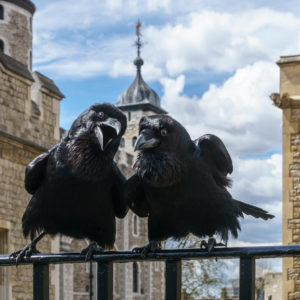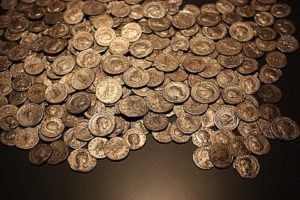Uncommon ravens: myths, facts and macroeconomics

Two ravens, Huginn and Muninn, sit on Odin’s shoulders in an illustration from an 18th-century Icelandic manuscript. Image: public domain
Over the past two decades, biologists have been busy studying one of our native mythological birds. At once the most widely distributed member of the crow family, and a figure revered across the globe by civilizations both ancient and modern, the common raven (Corvus corax) is anything but ordinary.
In Norse mythology, the god Odin had two ravens who flew around the world gathering information for him, and the Irish giant and culture-hero Cú Chulainn was honored by a visit from the goddess Morrígan who appeared as a raven. To the modern Haida and Tlingit peoples out West, the raven is a bird of surpassing intelligence, as well as a culture-hero who is responsible for creating humans, and causing much mischief as an inveterate trickster.

Jubilee and Munin, two of the ravens of the Tower of London. Photo: Colin, Creative Commons, some rights reserved
In the Tower of London, a flock of at least six ravens have been kept at great taxpayer cost since the late 1600s (just to mention, today’s ravens are not the original ones—they live about 40 years in captivity). A Ravenmaster is the guy whose life is dedicated to the care of this flock, for the simple reason that according to legend, ravens keep both the tower and the British monarchy from falling. Given the impending “Brexit,” though, maybe someone should check on those birds.
In North America, ravens can be distinguished from crows by their size. On average, ravens are 63 centimeters or 25 inches long, and weigh about 1.2 kilograms or 2.6 pounds. Wingspans are about 150 cm or 51 inches. In contrast, American crows average 45 centimeters or 18 inches long, and weigh only 0.45 kilograms or about one pound. Their average wingspan is 93 centimeters or 36 inches. Ravens also have rough feathers on their throats, and on the upper surface of the base of their bills.
Ravens do not migrate, unlike crows, and they prefer more elbow room than crows, favoring rural, often remote, environments. Known for their aerial acrobatics, ravens are one of the few bird species known to play games with mammalian species, and the only bird known to choose and fashion objects whose sole purpose is for use as toys.
There are at present six recognized subspecies of Corvus corax, all the more cause for not referring to them as common. These birds have been under the figurative microscope of late for reasons other than to find if they really do keep the Tower of London standing vertically. Biologists set about to quantify how smart ravens really are—which is VERY.
 In studies conducted between 2015 and 2017 at Sweden’s Lund University and published in the journal Science, researchers found that ravens were better than chimpanzees at problem-solving tasks. And that they were better than human four-year-olds in planning ahead to obtain a tool necessary to open a box containing treats. In the words of Mathias Osvath, a raven-cognition expert at Lund University, “I’m a little bit surprised they were that good. Monkeys have not been able to solve tasks like this.”
In studies conducted between 2015 and 2017 at Sweden’s Lund University and published in the journal Science, researchers found that ravens were better than chimpanzees at problem-solving tasks. And that they were better than human four-year-olds in planning ahead to obtain a tool necessary to open a box containing treats. In the words of Mathias Osvath, a raven-cognition expert at Lund University, “I’m a little bit surprised they were that good. Monkeys have not been able to solve tasks like this.”
The same research team also tested ravens’ ability to barter, and found they were very disciplined at trading tokens for a high-value treat at a later time rather than for a common treat in the moment (yet another reason to drop the moniker “common” raven, I say). They were considerably better at delaying gratification than any great-ape hominid previously tested.
An international study conducted in 2016 and published in Nature Communications proved that ravens could think in the abstract. Ravens inside a closed room would hide food if a small peephole was open, but not when it was shut, indicating they could imagine being spied upon. It could be evidence they are somewhat paranoid, though, but I don’t think that was the point.
Perhaps the most significant finding is that ravens show evidence of displacement, the ability to relate information on events removed in space and time. While young ravens roost communally but disperse each morning to forage, a lone juvenile will apparently report the presence of a large food cache guarded by a few adults which it saw that day. The following day, a large number of young ravens will organize to drive off the few adults from the food source. I suppose this could be evidence of juvenile delinquency as well as the ability to plan for future, distant events. Ravens are now the only vertebrate known to share this trait with humans.
Along with their corvid cousins the magpies and rooks, ravens pilfer and cache shiny objects, often coins. No one is sure if this is curiosity, or whether it is to gain status. My son, whose name is Raven (true story), happens to work in the Economics Department at the University of Massachusetts at Amherst. He offered this alternate explanation:

Raven bait – a horde of gold coins. Rooks apparently prefer federal reserve notes. Photo: Rabenspiegel, Creative Commons, some rights reserved
“Also, a little-known fact: most corvids will collect coins because they are gold-standard holdouts who don’t believe in fiat currency. These birds historically opposed the printing of so-called greenbacks (dollars not backed by gold reserves) during various wars, and today refuse to use paper money on ideological grounds. They prefer precious metals, but have a very difficult time distinguishing between precious and common metals—hence why they will generally take any shiny coins they can get.
The great exception is rooks, who are all chartalists—they believe the value of money is derived from the government’s willingness to accept it in payment for tax debts—that this is in fact the defining characteristic that makes something money. These birds have thus adopted paper money, and will always take a bill with higher face-value if given a choice. Rooks care about chartalismbecause they are naturally very law-abiding and are in fact one of the few bird species that regularly pay their taxes every year.
However, it’s hard to know for certain because polling ravens is difficult—they rarely answer pollsters’ phone calls, try to steal shiny things during in-person interviews, and are, anyway, mostly raven lunatics. Of course, both of these monetary theories are for the birds.”
I’d say that’s a very uncommon Raven.
Paul Hetzler is a horticulture and natural resources educator with Cornell Cooperative Extension of St. Lawrence County. And check out paulhetzlernature.org where humor and science collide–amicably for the most part.








I have always loved Ravens. They can be taught to talk and can do some counting as well.